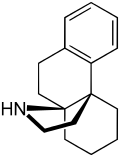Hasubanan
Hasubanan is an alkaloid with the chemical formula of C16H21N. It forms the central core of a class of alkaloids known collectively as hasubanans.[1] The compound is derived from reticuline, as is morphinan, but is comparatively more oxidized and rearranged. It is similar to acutumine.
 | |
| Names | |
|---|---|
| IUPAC name
(3aS-cis)-2,3,4,5-Tetrahydro-3a,9b-butano-1H-benz[e]indole | |
| Identifiers | |
3D model (JSmol) |
|
| ChEBI | |
| ChemSpider | |
PubChem CID |
|
CompTox Dashboard (EPA) |
|
| |
| |
| Properties | |
| C16H21N | |
| Molar mass | 227.351 g·mol−1 |
Except where otherwise noted, data are given for materials in their standard state (at 25 °C [77 °F], 100 kPa). | |
| Infobox references | |
See also
References
- Zhang H, Yue J (2005). "Hasubanan type alkaloids from Stephania longa". J Nat Prod. 68 (8): 1201–7. doi:10.1021/np0500833. PMID 16124761.
External links
This article is issued from Wikipedia. The text is licensed under Creative Commons - Attribution - Sharealike. Additional terms may apply for the media files.